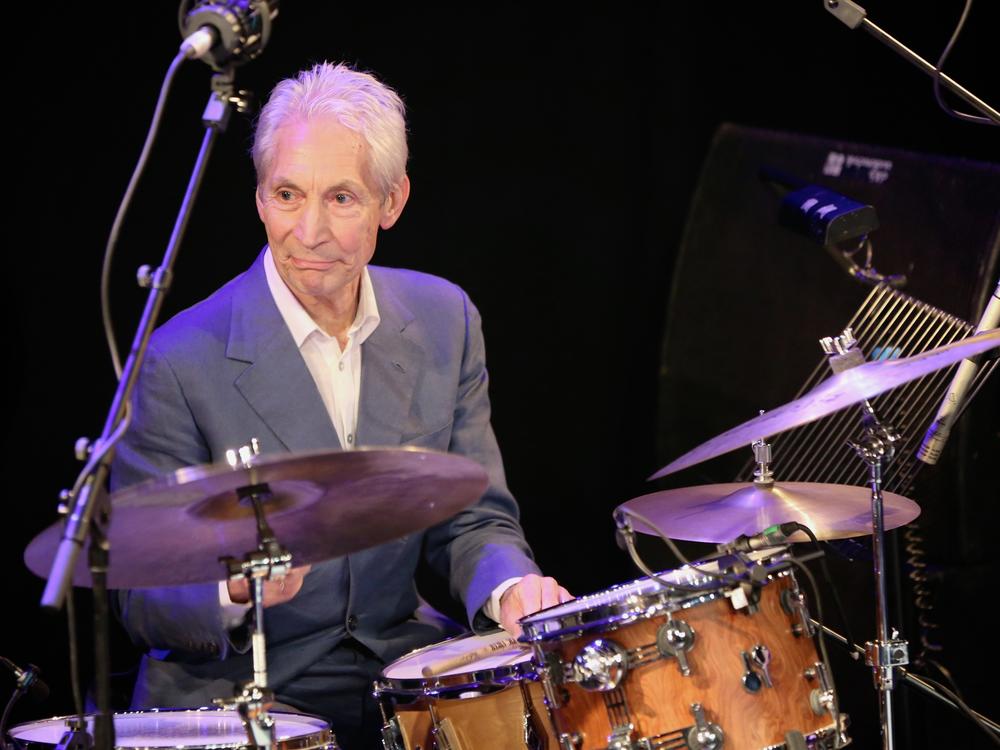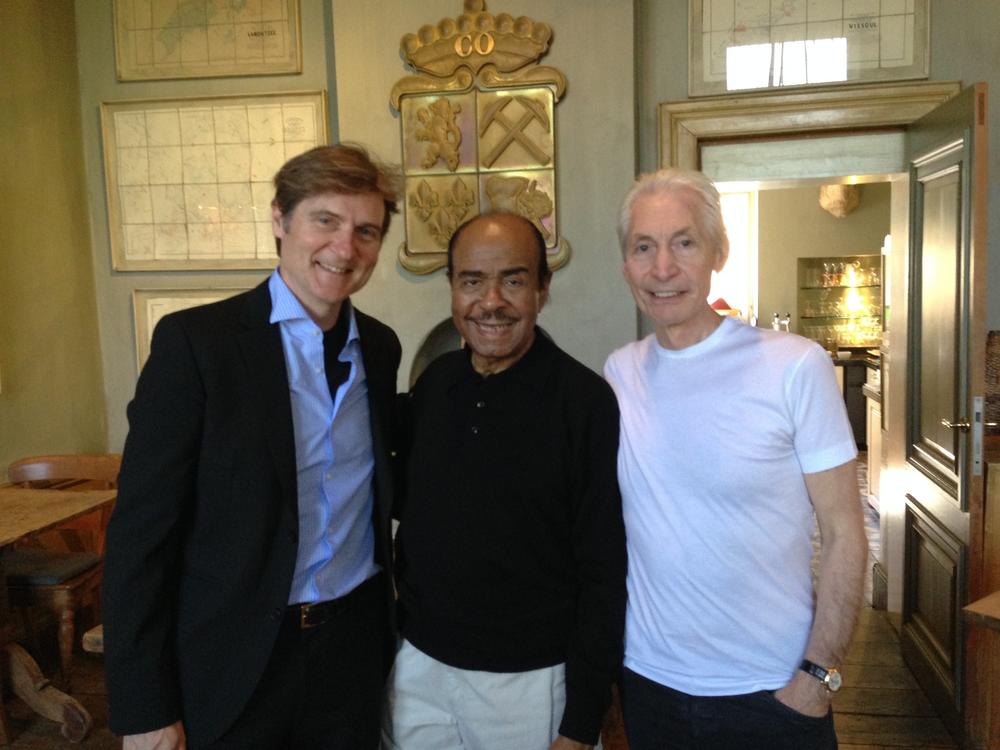Section Branding
Header Content
I Played Jazz With Charlie Watts For 20 Years. Here's What I Learned
Primary Content
Musician Tim Ries has been a touring member of The Rolling Stones since 1999, playing woodwinds and keys. But he also enjoyed a special relationship with drummer Charlie Watts, as their shared love of jazz bloomed into a series of collaborations. Watts died Aug. 24 at age 80; below is Ries' remembrance of a few exceptional moments from their two-decade friendship.
On my first tour with The Rolling Stones, I remember looking over at Charlie Watts during "Moonlight Mile." My keyboard was set up close to his drum kit, facing him, almost how it would be if we were on a small club stage instead of in an arena. I'd been hired in January 1999 as part of the band's incredible extended ensemble: playing saxophone in the horn section along with Bobby Keys, trumpeter Kent Smith and trombonist Michael Davis, as well as keyboard, piano and organ next to Chuck Leavell. But during that song, whose drum part is played with mallets, I listened to Charlie and all I could hear was Elvin Jones, playing a mallet part behind John Coltrane.
The thought was still with me when I got back home to New York. When I recorded my next jazz album, Alternate Side, for the European label Criss Cross, I snuck in an instrumental version of "Moonlight Mile" as a tribute to what I'd experienced. I just couldn't get over how Charlie played.
It is no secret that Mr. Watts was a lover of jazz, that great American music, that swing. And much has been written about how that love helped shape the sound of the Stones, through the legacy of the many brilliant drummers he listened to as a young man growing up in England. But those who knew him will tell you that his life wasn't defined by keeping time, but by giving it — to friends and near-strangers and the music he loved, whether on or off the bandstand.
Just before the next Stones tour, for the 40th anniversary compilation Forty Licks, I got an idea: to arrange an album's worth of the band's songs for a jazz group to perform. For players, I would draw from my circle of musician friends in New York — John Patitucci on bass, Brian Blade on drums, Ben Monder on guitar and Bill Charlap on piano. And maybe, I thought, I could convince Charlie to participate on a track or two.
As rehearsals began, I shared a few demos with Mick Jagger and Keith Richards, just to be sure I had their blessing. Then, on a flight from Atlanta to Los Angeles, I asked Charlie if he might take part in the sessions. "Absolutely," he said. "And you should ask Keith."
I was gobsmacked. "Ask Keith?"
"Yes," he replied. Then, before I could react, he added: "I'll ask him."
And with that, he walked to the front of the plane. I was still processing the shock when he returned a moment later with Keith and Ronnie Wood behind him. Keith said, "We're all in, mate." I was speechless. My little jazz quintet date was becoming something quite different.
At that next session in LA, the expanded lineup included Charlie, Keith and Ronnie, Stones bassist Darryl Jones and organist Larry Goldings, and one of the band's frequent opening acts, Sheryl Crow. We recorded Keith's song "Slipping Away," one of my favorites, and "Honky Tonk Women," with the saxophone playing the lead vocal part and Sheryl and Keith singing backup. At the end of the day, everyone had left except for Charlie, Larry and me. I asked Charlie if he would mind trying one more pass at "Honky Tonk Women" as an organ trio, the way you might hear Jimmy Smith or Brother Jack McDuff do it. He immediately said yes, and the three of us recorded the song in one take. Larry put down a serious groove, and Charlie, I must say, was swinging his ass off.
For the next few years, I recorded in locations all around the world while the Stones were on tour. I eventually released two full albums of their music: The Rolling Stones Project, on Concord Records in 2005, and Stones World: The Rolling Stones Project II, on Sunnyside Records in 2008. There were sessions in Munich and Portugal, in Paris and London, and the roster of guests grew to include around 80 musicians and singers, with even Mick joining in on the second record. And every time I asked Charlie to participate, he said yes.
Once those recordings were out, I started to spend my off nights on tour performing gigs with Bernard Fowler, who has been singing backup with the Stones since the late '80s. Over and over, Charlie would come to those shows to listen to who I had in the band. When jazz drummers go out to see other groups perform, there is a history, I would even say a childlike passion, of finding a seat in the house as close as possible to the drummer, so they can observe their playing up close: the ride cymbal patterns, the left hand technique, the bass drum and hi-hat footwork. (You'll see this if you ever visit the Village Vanguard in New York, where there is seating basically right next to the drummer's position onstage.) Charlie would watch the drummers and get inspired — and in many instances, even though he was mainly there to hang, he would wind up joining us onstage by the end of the night. I daresay he came to 50 gigs and sat in at 48 of them.
On nights when I didn't have a gig, Charlie and I would go see which jazz groups were playing at clubs and theaters in the cities our route took us through — not just New York but Chicago, Detroit, Melbourne, Sydney, Mexico City, Tokyo. He was famously indifferent to the glamour of the rock and roll touring life, but when he was on the jazz scene he was really in his element: He could hang with all the cats, because he was one of the cats. Still, even he could be starstruck from time to time. One night in Pittsburgh, we went to hear the Dizzy Gillespie All-Star Big Band, which featured Frank Wess, James Moody and Jimmy Heath in the sax section. Backstage, Charlie was like a young boy again, in disbelief that he was standing in the same room as three of his heroes. Just when it seemed like things couldn't get better, Jimmy Heath got our attention and started dancing around the dressing room. This jazz master, for our amusement, was doing his best Mick Jagger impression. Charlie got quite a chuckle from that sight.
We heard so much incredible music on those nights out, and after each gig we would go backstage to rap to the musicians. Of course, everyone knew who Charlie was. But to their surprise, he knew who they were as well. Beyond the the 1940s and '50s jazz he'd grown up with, he was always interested in listening to the newest and youngest stars on the scene, and he always took the time to visit and chat with each player — not as the star that he was, but just as a devoted lover of the music. Many of the musicians were friends of mine, and I would invariably get a call or an email the next day or even the same night, telling me how special the experience had been, how gentle and kind Charlie was to them.
The most important thing a drummer can offer to a band, and the most important thing one person can offer to another, is time. Charlie Watts exemplified this better than anyone I know. He used his time to celebrate the music that had given so much to him. He reveled in being around jazz players, but in those moments backstage and in the studio, he offered his attention to everyone else — to friends of friends, to people he'd never met — because they interested him too. He was The Rolling Stones' timekeeper for nearly 60 years, but when he wasn't onstage with the biggest rock band there ever was, he was giving all that time back.
Copyright 2021 NPR. To see more, visit https://www.npr.org.
Bottom Content





